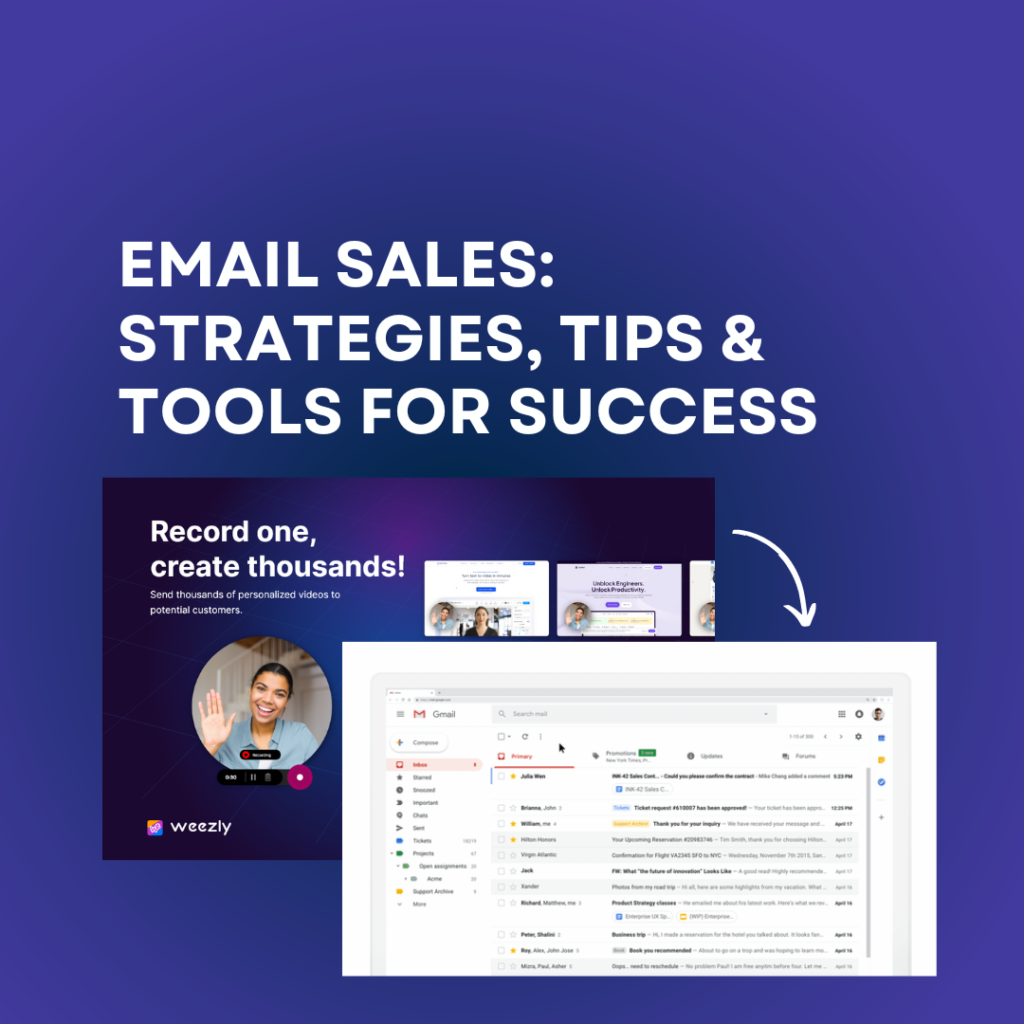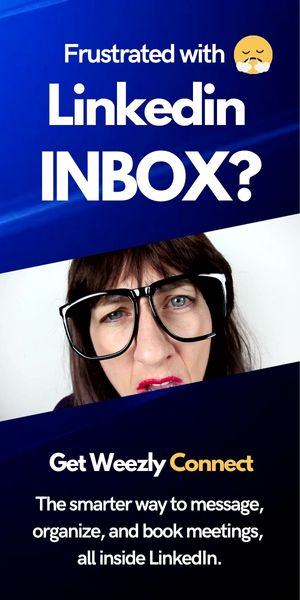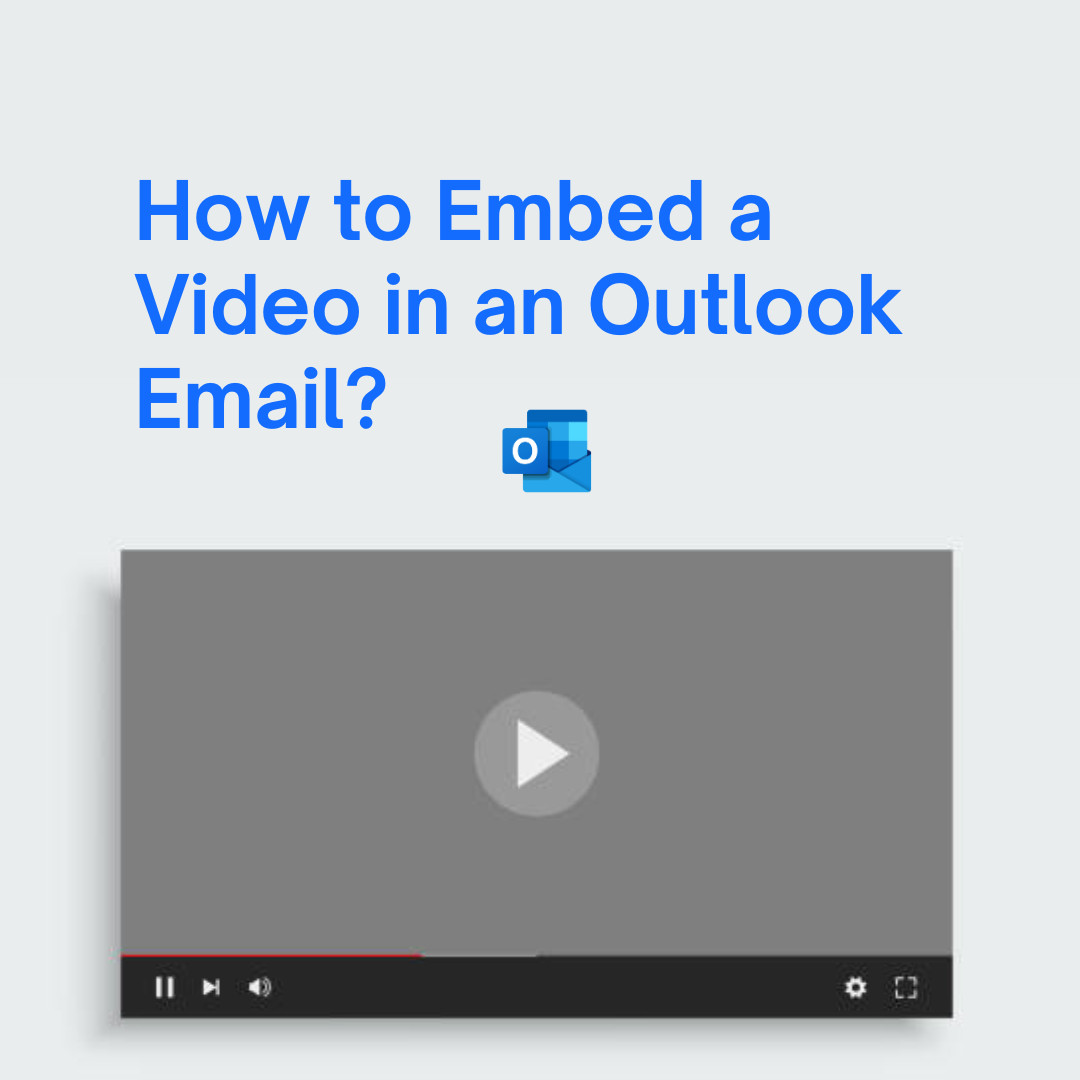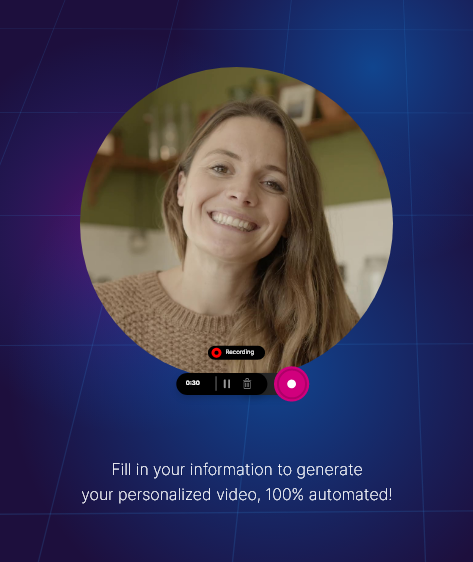In the rapidly evolving world of digital marketing, email sales remain one of the most effective and enduring methods of reaching potential customers and driving conversions. Despite the rise of social media and other forms of digital communication, email has continued to hold its ground as a reliable, direct, and personal way to engage with customers. Whether you’re a seasoned sales professional or a business owner looking to boost your revenue, mastering the art of email sales is essential.
This blog post dives deep into email sales, exploring proven strategies, expert tips, and the latest tools that can elevate your email marketing game. We’ll cover everything from crafting compelling emails to leveraging AI-powered tools like Weezly’s innovative video features to skyrocket your lead-generation efforts. By the end of this post, you’ll have a comprehensive understanding of optimizing your email sales strategy for maximum impact.

The Power of Email Sales: Why It Still Matters
Email sales, often referred to as email marketing, involves sending targeted emails to potential customers with the goal of generating leads, nurturing prospects, and ultimately closing sales. Despite the proliferation of new communication channels, email remains a cornerstone of successful sales strategies for several reasons:
- Direct Access to the Inbox: Unlike social media posts or advertisements that can be easily overlooked, emails land directly in your recipient’s inbox, providing a direct line of communication.
- Personalization: Email allows for a high degree of personalization, enabling you to tailor your message to the specific needs and interests of your audience.
- High ROI: Email marketing consistently delivers one of the highest returns on investment (ROI) of any marketing channel. According to the Data & Marketing Association (DMA), the average ROI for email marketing is $42 for every $1 spent.
- Scalability: Whether you’re sending out emails to a handful of prospects or thousands of potential customers, email marketing scales efficiently, making it suitable for businesses of all sizes.
Given these advantages, it’s clear that email sales is not just surviving but thriving in the digital age. However, to truly harness its power, it’s crucial to develop a well-thought-out strategy that combines best practices with the latest technological advancements.
Crafting the Perfect Sales Email: Key Elements to Consider
The success of an email sales campaign hinges on the quality of the emails you send. To craft emails that capture attention and drive action, consider the following key elements:
1. Subject Line
The subject line is the first thing your recipients will see, and it often determines whether they’ll open your email or send it straight to the trash. A compelling subject line should be concise, intriguing, and relevant to the recipient. Here are some tips for writing effective subject lines:
- Keep it Short and Sweet: Aim for subject lines that are 50 characters or fewer to ensure they display correctly on mobile devices.
- Use Action-Oriented Language: Encourage your recipients to take action by using strong verbs (e.g., “Discover,” “Boost,” “Get”).
- Create a Sense of Urgency: Phrases like “Limited Time Offer” or “Last Chance” can prompt immediate action.
- Personalize When Possible: Including the recipient’s name or a detail specific to them can increase open rates.
2. Opening Line
Once your email is opened, the first sentence needs to grab attention and set the tone for the rest of the message. Avoid generic greetings like “Dear Sir/Madam” and opt for a personalized approach that acknowledges the recipient’s specific needs or interests.
3. Body Content
The body of your email is where you deliver your message and convince the recipient to take the desired action. To keep your audience engaged:
- Be Clear and Concise: Avoid long-winded explanations and get to the point quickly.
- Highlight Benefits: Focus on how your product or service can solve the recipient’s problems or meet their needs.
- Use Bullet Points: Break up text with bullet points to make it more readable and emphasize key benefits.
- Include Social Proof: Testimonials, case studies, or statistics can build credibility and reinforce your message.
4. Call to Action (CTA)
The CTA is arguably the most critical part of your email. It’s the action you want the recipient to take, whether it’s scheduling a demo, making a purchase, or downloading a resource. A strong CTA should be:
- Clear and Specific: Use straightforward language that leaves no room for confusion (e.g., “Schedule Your Free Consultation Today”).
- Visually Prominent: Use buttons or bold text to make your CTA stand out.
- Linked to a Landing Page: Ensure your CTA directs recipients to a relevant landing page that continues the conversation and makes it easy for them to take the next step.
5. Closing and Signature
End your email with a polite and professional closing. Your signature should include your name, title, company, and contact information. Consider adding a professional headshot and social media links to further personalize your email.
READ MORE: 18 Better Options to Say “Thank You for Your Understanding”
6. A/B Testing
To continuously improve your email sales performance, conduct A/B testing on various elements of your emails, such as subject lines, CTAs, and send times. Analyzing the results will help you identify what resonates best with your audience and optimize future campaigns accordingly.
Advanced Email Sales Techniques: Going Beyond the Basics
While mastering the basics of email sales is essential, advancing your strategy with more sophisticated techniques can lead to even greater success. Below are some advanced email sales techniques to consider:
1. Segmentation
Segmenting your email list allows you to send more targeted and relevant emails. By categorizing your contacts based on factors like demographics, behavior, and purchase history, you can tailor your messaging to better meet the needs of each group. Some common ways to segment your email list include:
- Demographic Segmentation: Segment by age, gender, location, job title, etc.
- Behavioral Segmentation: Segment based on past interactions with your emails, website activity, purchase history, etc.
- Engagement Segmentation: Segment by engagement level, such as active subscribers versus those who haven’t opened an email in the past six months.
2. Personalization
Beyond simply addressing the recipient by name, advanced personalization can involve dynamic content that changes based on the recipient’s preferences or behavior. For example:
- Product Recommendations: Use past purchase data to recommend products that align with the recipient’s interests.
- Tailored Offers: Offer discounts or promotions that are relevant to the recipient’s past interactions with your brand.
- Behavior-Triggered Emails: Send automated emails based on specific actions taken by the recipient, such as abandoning a cart or downloading a resource.
3. Automated Drip Campaigns
Drip campaigns are a series of automated emails sent to prospects over time, usually triggered by specific actions or time intervals. These campaigns are particularly effective for nurturing leads and guiding them through the sales funnel. Key benefits of drip campaigns include:
- Consistent Engagement: Regular touchpoints keep your brand top-of-mind without overwhelming your prospects.
- Lead Nurturing: Gradually introduce more information and incentives as the recipient moves closer to making a purchase.
- Scalability: Once set up, drip campaigns can run automatically, saving time while maintaining consistent communication.
4. Interactive Content
Interactive emails, which include elements like polls, quizzes, and surveys, can significantly boost engagement by encouraging recipients to actively participate in the content. For example:
- Quizzes: Create a quiz that helps recipients identify the best product or service for their needs.
- Surveys: Gather feedback on customer satisfaction or product preferences.
- Polls: Engage recipients by asking for their opinion on a relevant topic.
5. AI-Powered Tools
Artificial intelligence (AI) is revolutionizing email sales by enabling more precise targeting, personalization, and automation. One standout tool in this space is Weezly, which offers AI-driven sales video features that can dramatically enhance your email campaigns. Weezly allows you to send thousands of personalized video emails, which can help capture attention and boost engagement rates. Some key benefits of using Weezly include:
- Personalized Video Messages: Create and send personalized video messages at scale, helping to build a stronger connection with your audience.
- Automated Lead Generation: Weezly’s AI features can identify and target high-potential leads, improving your conversion rates.
- Enhanced Engagement: Video content is more engaging than text alone, making it more likely that recipients will take action after viewing your message.
By incorporating AI-powered tools like Weezly into your email sales strategy, you can stay ahead of the competition and achieve better results.
Common Email Sales Mistakes to Avoid
While email sales can be highly effective, there are common pitfalls that can undermine your efforts. Avoiding these mistakes will help ensure your campaigns are successful:
1. Neglecting Mobile Optimization
With more than half of all emails being opened on mobile devices, it’s essential that your emails are mobile-friendly. This includes using responsive design, ensuring that text is easily readable, and making sure CTAs are easy to tap.
2. Overloading with Information
Providing too much information in a single email can overwhelm your recipients and cause them to lose interest. Keep your emails focused on one main message and save additional details for subsequent emails or linked landing pages.
3. Ignoring Compliance Regulations
Email marketing is subject to various regulations, such as the CAN-SPAM Act in the U.S. and GDPR in the EU. Failing to comply with these regulations can result in fines and damage to your reputation. Key compliance practices include:
- Obtaining Consent: Ensure that recipients have opted in to receive your emails.
- Providing an Unsubscribe Option: Include a clear and easy way for recipients to unsubscribe from your emails.
- Including Your Physical Address: Make sure your company’s physical address is included in every email.
4. Sending Too Frequently
While it’s important to stay in touch with your audience, bombarding them with too many emails can lead to fatigue and increased unsubscribe rates. Find a balance by monitoring engagement metrics and adjusting your send frequency accordingly.
5. Failing to Segment Your List
Sending the same generic email to your entire list can result in lower engagement and higher unsubscribe rates. Take the time to segment your list and tailor your messaging to different groups for better results.

Measuring the Success of Your Email Sales Campaigns
To ensure that your email sales efforts are yielding the desired results, it’s crucial to track and analyze key performance metrics. Here are some important metrics to monitor:
1. Open Rate
The open rate indicates the percentage of recipients who opened your email. A low open rate could suggest that your subject line or sender name needs improvement.
2. Click-Through Rate (CTR)
CTR measures the percentage of recipients who clicked on a link or CTA within your email. A high CTR indicates that your content and offer are resonating with your audience.
3. Conversion Rate
The conversion rate tracks the percentage of recipients who completed the desired action (e.g., making a purchase, signing up for a webinar). This is a critical metric for assessing the effectiveness of your email sales strategy.
4. Bounce Rate
Bounce rate refers to the percentage of emails that were not successfully delivered to recipients’ inboxes. High bounce rates can hurt your sender reputation, so it’s important to maintain a clean and updated email list.
RELATED ARTICLE: How to Improve Email Deliverability?
5. Unsubscribe Rate
The unsubscribe rate indicates the percentage of recipients who opted out of your email list after receiving a campaign. Monitoring this metric can help you identify if your content is misaligned with your audience’s expectations.
6. Return on Investment (ROI)
Ultimately, the success of your email sales efforts should be measured by ROI. Calculate the revenue generated from your campaigns against the costs associated with them to determine their profitability.
Best Practices for Email Sales Success
To wrap up, here are some best practices that can help you achieve success with your email sales campaigns:
1. Regularly Clean Your Email List
Periodically remove inactive or invalid email addresses from your list to maintain high deliverability and engagement rates.
2. Focus on Quality Over Quantity
Sending fewer, more targeted emails is often more effective than bombarding your list with frequent, generic messages.
3. Test and Optimize Continuously
Use A/B testing to experiment with different elements of your emails, such as subject lines, content, and CTAs. Continuously optimize based on the results to improve performance over time.
4. Use AI-Powered Tools
Leverage AI-driven tools like Weezly to automate and enhance your email sales efforts. AI can help you identify high-potential leads, personalize your messaging, and ultimately boost your sales.
5. Monitor Metrics and Adjust Strategies
Keep a close eye on key performance metrics and be ready to adjust your strategies based on the data. Flexibility and responsiveness are key to staying ahead in the competitive landscape of email sales.
Conclusion
Email sales remains one of the most powerful tools in a marketer’s arsenal, offering direct access to potential customers, high ROI, and endless opportunities for personalization and automation. By mastering the art of crafting compelling emails, utilizing advanced techniques like segmentation and AI-powered tools, and continuously optimizing your strategy, you can significantly boost your sales and grow your business.
As you refine your email sales strategy, consider incorporating cutting-edge tools like Weezly, which offers AI-driven video features that can help you send personalized videos to thousands of leads, making your campaigns more engaging and effective. Whether you’re just starting with email sales or looking to take your efforts to the next level, the strategies and tips outlined in this post will help you achieve your goals and drive measurable results.
Remember, the key to success in email sales lies in the details—every element of your campaign, from the subject line to the CTA, plays a crucial role in capturing attention and driving conversions. By focusing on quality, personalization, and continuous improvement, you’ll be well on your way to mastering email sales and achieving long-term success.
EXPLORE MORE: Effective Email Marketing Strategies: B2B Lead Generation








